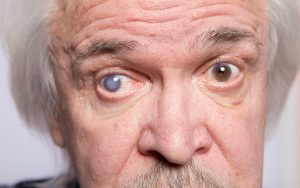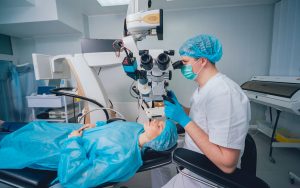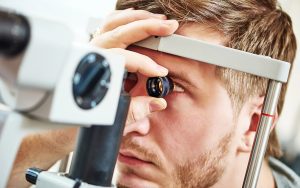All You Need To Know About Presbyopia

Presbyopia is an ocular condition where the eye slowly loses its ability to focus quickly on items near it. It is a condition that affects everybody at one point in their natural aging process.
Light passes through the cornea when it enters the eye. After the cornea, it then passes through the pupil.
The iris, a colored ring in the eye that closes and opens the pupil, helps regulate how much light gets through it. After light passes through this colored ring, it goes through the lens, and when the lens is healthy, it will change shape to bend light rays and focus them on the retina.
However, the lens becomes less flexible with age progression. At some point, it will not be able to change shape as quickly and efficiently. As a result, it cannot bend light rays properly and focus them on the retina.
What Causes Presbyopia?
When you are young, the lenses in the eyes are relatively elastic and more flexible. The lenses can change their shape and length with the help of the small rings of muscles surrounding them. These tiny muscles can easily reshape and adjust the lenses to accommodate distant and close objects.
As you get older, your lenses lose flexibility and stiffen. As a result, they gradually lose the ability to change shape and focus on close objects properly. Thus, your eyes gradually lose their ability to concentrate light rays onto the retina.
What Are The Symptoms?
The most common signs and symptoms of this condition occur between 40 to 45 for most people. The symptoms usually involve a gradual decline in the eye’s ability to do work or read up close.
Some of the most common signs and symptoms include:
- Headaches and eyestrain right after working up close or reading
- Struggling to read tiny print
- Needing bright light reading or working up close
- Strictly gaining focus on reading material held at arm’s length
- Squinting
Farsightedness, or hyperopia, has signs and symptoms very similar to presbyopia. But they are different eye conditions.
In both cases, distant items are clear, but the closer ones appear blurry. Farsightedness happens when the cornea is too flat or when the eyes are shorter than usual. With these disorders, especially presbyopia, light focuses on the retina.
Risk Factors of Presbyopia
Age is the most common risk factor for this ocular condition. Most people will gradually lose the ability to focus on nearby objects by the time they hit 40. This can affect anyone, but some people notice it earlier.
Some drugs can cause this disorder in people younger than 40. When the signs and symptoms show themselves earlier than usual, it is known as premature presbyopia.
In addition, underlying medical conditions can trigger these symptoms in people younger than 40. You are at a high risk of suffering premature presbyopia if you have the following:
- Anemia
- Cardiovascular disease
- Diabetes
- Farsightedness, or hyperopia
- Myasthenia gravis
- Multiple sclerosis
- Vascular insufficiency
How Do Doctors Treat Presbyopia?
Unfortunately, there is still no cure for this condition. However, various treatments help to correct vision. Depending on your lifestyle and condition, you might be able to pick from corrective lenses or surgery to rectify your vision.
Prescription Lenses
You may need to get prescription lenses and another separate prescription if you have lenses to rectify another eye complication. There are many variations of prescription lenses, including;
- You can use prescription reading lenses if you only have presbyopia and do not want something off the shelf.
- Bifocals, which have two different focus options.
- Progressive lenses.
- Trifocals.
- Monovision contact lenses.
Keep in mind that your eyes will still gradually lose their ability to focus on nearby objects as you age, which means you will need to keep reviewing and changing your prescription.
Non-prescription lenses
If you did not need glasses before developing presbyopia, you might be eligible for non-prescription reading glasses. These glasses are available at retail shops, like the local drugstore.
When choosing non-prescription glasses, try different magnification levels. Pick a magnification that will allow you to read a magazine or newspaper comfortably.
Surgery
There are several surgical procedures for treating presbyopia. For instance;
- CK (Conductive Keratoplasty)- involves using radiofrequency energy rays to change the cornea’s curvature. While it is a very effective treatment, the correction can sometimes diminish over time.
- LASIK (Laser-Assisted In-Situ Keratomileusis)- which specialists use to create monovision. This medical adjustment rectifies one of your eyes for distance and the other for vision.
- Refractive Lens- which involves eliminating the natural lens. The natural lenses are then replaced with synthetic ones, known as intraocular lens implants.
Presbyopia and Eye Exercises
Some studies and experts suggest that exercise can improve symptoms of presbyopia. The studies indicate that improving the speed and accuracy of visual processing can, in turn, improve comprehension.
These studies state that eye exercises such as looking at strategically-placed Gabor patches can help with presbyopia symptoms. Similarly, some experts suggest that perceptual learning can retrain the part of the brain that deals with vision, thus improving signs of presbyopia.
However, it is important to note that these eye exercises are time-consuming. Thus, other forms of treatment offer faster and often better results.
The Takeaway
In most cases, you can use surgery, contact lenses, or glasses to restore your vision if you have presbyopia. Unfortunately, there is still no proven way to prevent this condition. The gradual deterioration of the eye is something that affects every human being.
With that said, it is important to protect your eye health actively. Practice wearing sunglasses outside, getting regular eye exams, controlling chronic health conditions, etc. Keeping up with these protective activities should improve eye health for longer.
Our facility is fully equipped to diagnose and treat symptoms of presbyopia. If you notice these symptoms, book an appointment to ensure you receive a prompt diagnosis to improve your chances of recovery.
Similarly, you can book regular eye exams to learn more about your ocular health. Our doctors will be able to detect any signs of deterioration or infection, improving the chances of recovery. Reach out today to learn more about this and other eye conditions.




